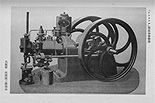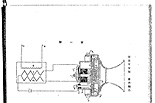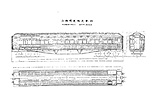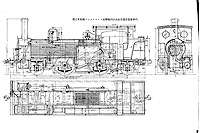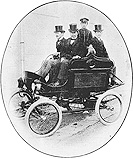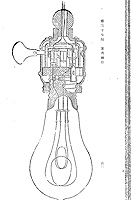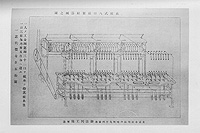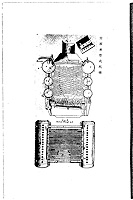(3) Company Growth and the End of National Industrial Exhibitions
Fifth National Industrial Exhibition, 1903, Osaka
At the fifth National Industrial Exhibition, more than half of the high-ranking award winners were from private companies, indicating the growth of domestic industries. Also, more than half of the exhibits were industrial items.
The Sino-Japanese War made the Japanese government realize that the country did not have sufficient vessels. From the late 1890s, the government began to promote the development of the shipbuilding industry. Although the level of Japanese shipbuilding failed to catch up with that of Europe or the United States, the Japanese shipbuilding industry certainly underwent significant development. At the fifth National Industrial Exhibition, awards were granted to Mitsubishi Shipyard, Kawasaki Shipyard and Osaka Iron Works for their ship models, in recognition of not only the quality of the models themselves, but also their wide contribution to the shipbuilding industry. Such contribution included the installation of machinery and facilities for shipbuilding and the training of engineers. Also, an award was granted to an exhibitor of a steam locomotive. Meanwhile, automobile exhibits were still at the stage of simple demonstrations of imported products.
In the category of electricity, awards were given for an electric communication machine by Kibataro Oki, a telephone by Nippon Electric (established jointly in 1899 with Western Electric of the United States), and electric lamps by Tokyo Electric Company (the forerunner of Toshiba Co.), in recognition of their high quality and low prices. Moreover, an award was granted for a dry cell battery by Senzo Yai. It seems that his award was given in recognition of the fact that his battery was already being exported to foreign countries at the time of the fifth National Industrial Exhibition. An award was also granted for a dynamo by Shibaura Engineering Works, although this machine used imported items for its internal parts.
In the category of spinning, Naosaburo Minorikawa exhibited a 12-roller silk reeling machine. This machine enhanced the productivity of silk reeling, paving the way toward the domestic production of silk reeling machines.
In the category of prime movers, a total of 76 items were exhibited. An award was granted for a water tube boiler exhibited by Jiro Miyahara, a navy engineer. In addition to its high performance, this boiler featured major advantages due to its easy welding and maintenance, and the fact that it was manufactured and could be repaired in Japan. After a while, the boiler began to be used for warships.
At the fifth National Industrial Exhibition, the Japanese government permitted the foreign products to be exhibited and sold freely for the first time. Such items were exhibited at the Foreign Samples Building. In 1899, Japan joined the Paris Convention for the Protection of Industrial Property, leading to participation in the fifth National Industrial Exhibition by more than 10 countries, a greater number than expected. At the same time, Japan's joining the convention meant that Japan could no longer depend on imitations of foreign products.
Exhibits of the Fifth National Industrial Exhibition
Section 8, Machinery Exhibits
| Category | Machinery | No. of Exhibits | Image |
|---|---|---|---|
| 34 | Prime Movers | 76 | 12 |
| 35 | Power Transmission Machines and Mechanisms | 272 | - |
| 36 | Testing | 12 | - |
| 37 | Electricity | 723 | 3 |
| 38 | Transportation | 791 | 8 |
| 39 | Pumping, Water Lifting, etc. | 106 | 2 |
| 40 | Drying, Refrigerating, etc. | 13 | 1 |
| 41 | Agriculture, Forestry, Horticulture, and Fishery | 0 | - |
| 42 | Mining and Metallurgy | 3 | - |
| 43 | Chemical Industry | 68 | 1 |
| 44 | Dyeing and Weaving Industry | 189 | 1 |
| 45 | Manufacturing | 87 | 2 |
| 46 | Printing | 47 | - |
| 47 | Machine Tools | 2,154* | 1 |
| 48 | Civil Engineering and Construction | 54 | - |
| Total | 4,595* | 31 |
|
| Items Exhibited by Government Agencies | - | 2 |
|
* Category 47, "Machine Tools," includs 2,130 machine instruments (such as rasps) that had not been categorized in the Machinery Section at the fourth National Industrial Exhibition.
- Source:
-
Daigokai naikoku kangyo hakurankai jimukyoku.: Dai gokai naikoku kagyo hakurankai shinsa hokoku (Hasegawa Masanao, 1904)
- Reference:
The End of National Industrial Exhibitions
Amid the financial difficulties occured following the end of the Russo-Japanese War, the sixth National Industrial Exhibition eventually ended in cancellation. However, during the short span of about 25 years that the five National Industrial Exhibitions were held, the events witnessed the development of technologies, beginning with the creation of spinning-related machines, gradually followed by domestic production of large machinery, and the coming of the age of electricity. Additionally, the exhibition of individual inventors led to the establishment of companies. The items exhibited at the National Industrial Exhibitions indicate that the process of learning from and competing with foreign products and the inventions of others was steadily guiding Japan toward the replacement of manual labor by machinery in the Meiji period.
After the year 1900, Western-style iron and steel making commenced in Japan. This was accompanied by the development of hydroelectric power generation and long-distance electricity transmission, establishing electricity as a main power source. Against this background, Japan was transforming itself into an industrial society with an emphasis on military industry.
- References:
-
Gijutsu no shakaishi n. 3 (Yuhikaku, 1982) <M32-54>
Kuni, Takeyuki.: Hakurankai no jidai (Iwata shoin, 2005) <D7-H68>
Nakaoka, Tetsuro.: Nihon kindai gijutsu no keisei (Asahi shinbunsha, 2006) <M33-H31>
Nakaoka, Tetsuro (et al) (ed).: Sangyo gijutsushi: Shin taikei nihonshi. 11 (Yamakawa shuppansha, 2001) <M33-G31>
Nihon no rekishi: Kindai. 1-7 (Asahi shinbunsha, 2004) <GB71-H133>
Suzuki, Jun.: Meiji no kikai kogyo (Mineruva shobo, 1996) <DL413-G5>

